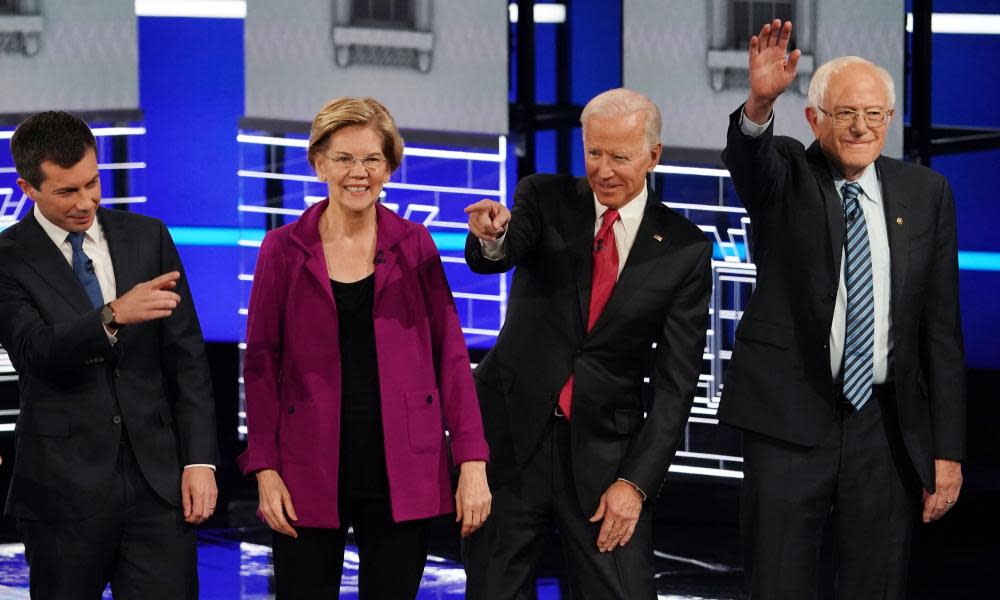Too many Democrats are running for president in 2020. But there's an easy fix

Democrats in Iowa will caucus in early February, barely two months away, and finally cast the first votes of presidential nomination season.
There’s an elite tier of four candidates: former vice-president Joe Biden, South Bend mayor Pete Buttigieg, the Vermont senator Bernie Sanders and the Massachusetts senator Elizabeth Warren. None of them, however, poll consistently above 30% in national surveys. Many Democrats see one or more of them as too old or too inexperienced; too far left or too moderate.
There’s another concern: with a total of 18 Democrats running just a few months ahead of the primary elections, a single candidate may never gain clear majority support, leading to a drawn out season. This is a persistent problem in U.S. politics (think of Trump’s rocky start in the crowded Republican field in 2016. But there is a simple, systemic fix.
Intra-party disputes owing to a multitude of contenders for the nomination are nothing new – and they can get bitter. In 2008, Barack Obama and Hillary Clinton battled deep into primary season. Tensions between Clinton and Sanders forces remained so sharp at the Democrats’ 2016 convention that many “Bernie or Bust”ers booed calls for unity.
In both of those races, however, there were only two candidates and a clear majority winner to ultimately rally around. That’s not likely to be the case this time. “Once you get a third candidate in the race that is pulling delegates away, then you start looking at the possibility of no candidate having a majority,” Jeffrey Berman, a former Democratic National Committee (DNC) rules committee member, told the Washington Post.
Now add a fourth candidate, and then a fifth. This clutter and chaos could certainly continue until Democrats convene next July. The four frontrunners, each with dynamic fundraising bases and growing stacks of delegates, would have no reason to exit. Neither would Michael Bloomberg or even Tom Steyer, propelled by personal fortunes, once the number of contests heats up, and the retail politics of Iowa and New Hampshire yield to megabucks Super Tuesday ad wars. Four candidates in their 70s wouldn’t want to wait until next time, especially if Donald Trump’s approval ratings remain stagnant and historically low.
These long campaigns serve one purpose: determining the presidential nominee an entire party can support. If four, or even five, candidates last all the way to the convention, the nominee might still be struggling to get above 30%. That’s a recipe for dangerous division, the same kind that plagued Republicans in 2016 when a large field also led to a plurality winner.
There is, however, a common-sense solution to this. Our political parties should continue to embrace ranked choice voting (RCV) in their nominating contests. RCV has become one of the most popular political reforms in the nation (adopted by voters in Maine, New York City and a growing number of smaller cities and towns) for this exact reason: it helps avoid plurality winners and determines the person who most people actually support. It’s built to pull consensus out of chaos like this.
RCV functions like an instant runoff. Suppose the choices narrowed down to Biden, Bloomberg, Buttigieg, Sanders and Warren. The candidate in fifth place is eliminated. His or her supporters select their second choice. That process continues until someone crosses 50% and wins.
If done nationally, the nominee would be the candidate who combines the ability to earn broad support with the largest and most passionate base. The supporters of losing candidates might not like the outcome, but Democrats would leave Milwaukee knowing it was fair and reflected popular opinion. The winner would have legitimacy; no one could claim the process had been rigged.
Democrats in five states this cycle will cast RCV ballots to make more votes count in their presidential primaries. But even without RCV in place everywhere, pollsters could use it to do a better job of accurately capturing public opinion. Surveys that show several candidates bunched together, all of them within the margin of error, actually do very little even to provide an accurate snapshot of a race compared to using rankings to simulate an “instant runoff”.
Related: The five ways Republicans will crack down on voting rights in 2020 | Carol Anderson
Here’s the simple truth. Today’s nominating process is fundamentally not equipped to determine a fair winner from today’s giant candidate fields, filled with both self-funding billionaires and leaders with passionate small-donor bases. This could be the year that this archaic machinery is completely overwhelmed, just as it nearly was for Republicans in 2016.
If that breakdown does not come this year, it will almost certainly occur in 2024, when at least one party, and quite possibly both, could hold nominating contests with even more candidates. A choice between two plurality winners will only exacerbate polarization and divides in the country. It shouldn’t be possible to have nominees – or winners – that a majority of the public opposes.
We’re voting the wrong way, debating spoilers and electability, and making choices with the help of flawed polling data. But we have time to get this right. It’s crucial that we do.
David Daley is the author of the forthcoming Unrigged: How Americans Are Battling Back to Save Democracy and a senior fellow at FairVote

